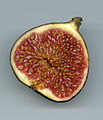Multiple fruit
Fruit cluster is a botanical term. In this type of fruit, which occurs in some gymnosperms and angiosperms, entire inflorescences that emerge from an inflorescence take on the appearance of a single fruit when ripe, which is then usually spread as a whole.
A fruiting unit develops from several flowers, each with its own carpels. Other floral organs, such as the perianth or the inflorescence axis, may be included (anthocarp) (pseudo-fruit).
A fruit cluster may be formed as an achene fruit cluster (e.g. figs, mulberries, jackfruit, milk orange), a nut fruit cluster, a berry fruit cluster (e.g. pineapple, delicious window leaf) or a stone fruit cluster.
A further distinction can be made between a sorosis (coenocarpium) as in jackfruit or pineapple, or a syconium as in figs and an achenoconum (strobilus) as in hops. In a sorosis, the fruiting association develops from inflorescences such as cobs, spikes, heads or catkins with a fleshy axis (rachis) and the fleshy perianth of the flowers, in a syconium from a fleshy, hollow receptacle, in a strobilus the association consists of several bracts and bracteoles which enclose achenes in the form of cones.
However, other forms of fruiting associations are possible, as in a "flower cake" (Coenanthium), the plate-shaped inflorescences of Dorstenia and Lecanthus species, an unclosed variety of Syconium (Hypanthodium), and many others.
In a few species, such as the honeysuckle, the ovaries of two adjacent flowers are partially or completely fused, forming a compound fruit (double berry, bibacca) rather than a fruiting union.
· 
True fig - Achene fruit association
· 
Pineapple - Berry Fruit Association
· 
White mulberry - Achene fruit association
· 
Double berry of Lonicera xylosteum
Search within the encyclopedia